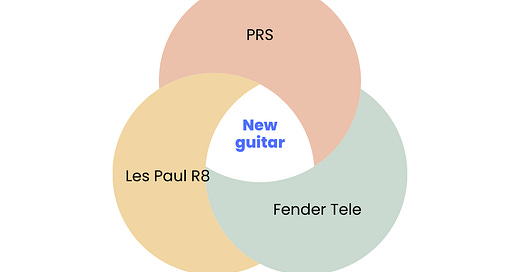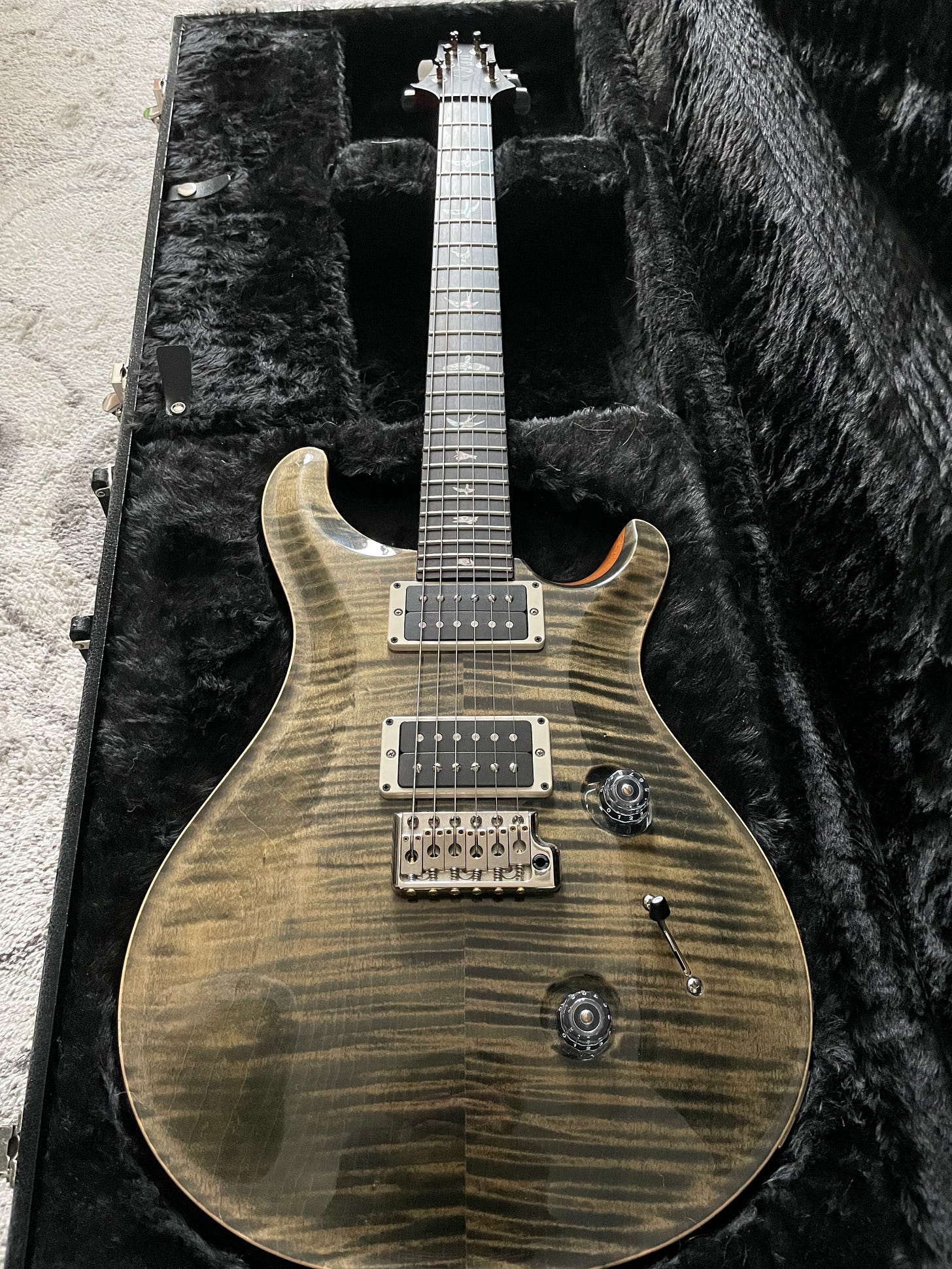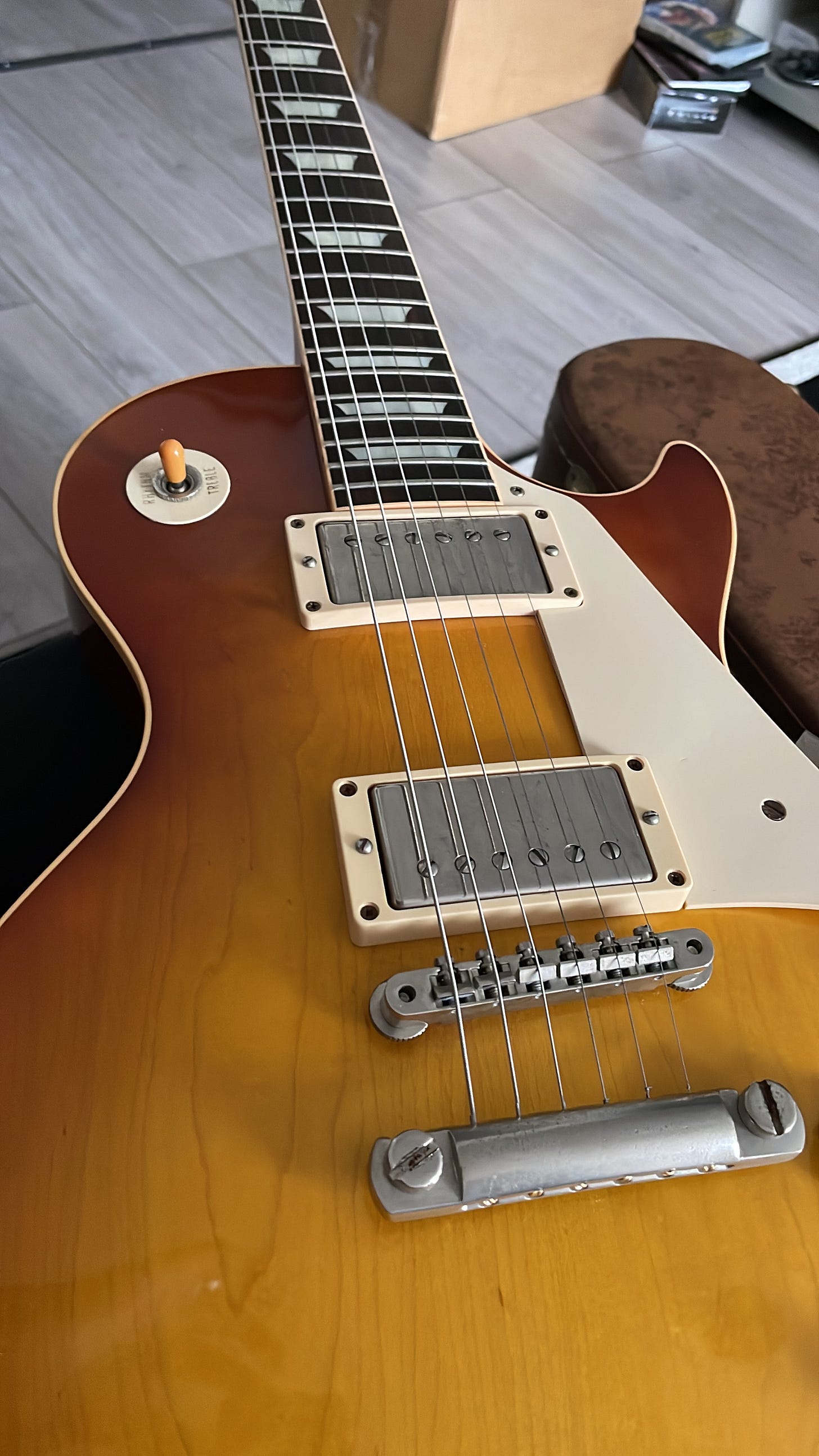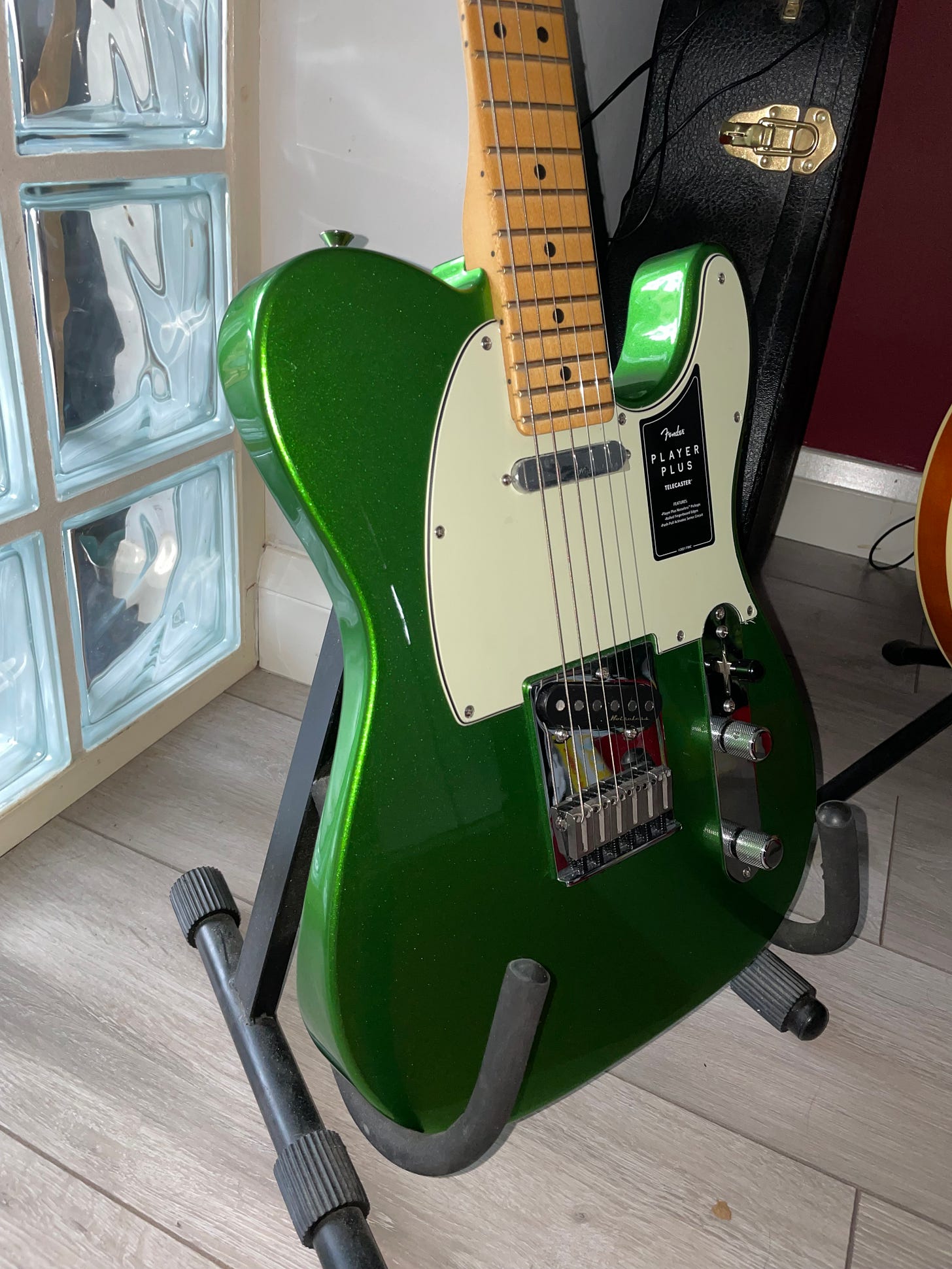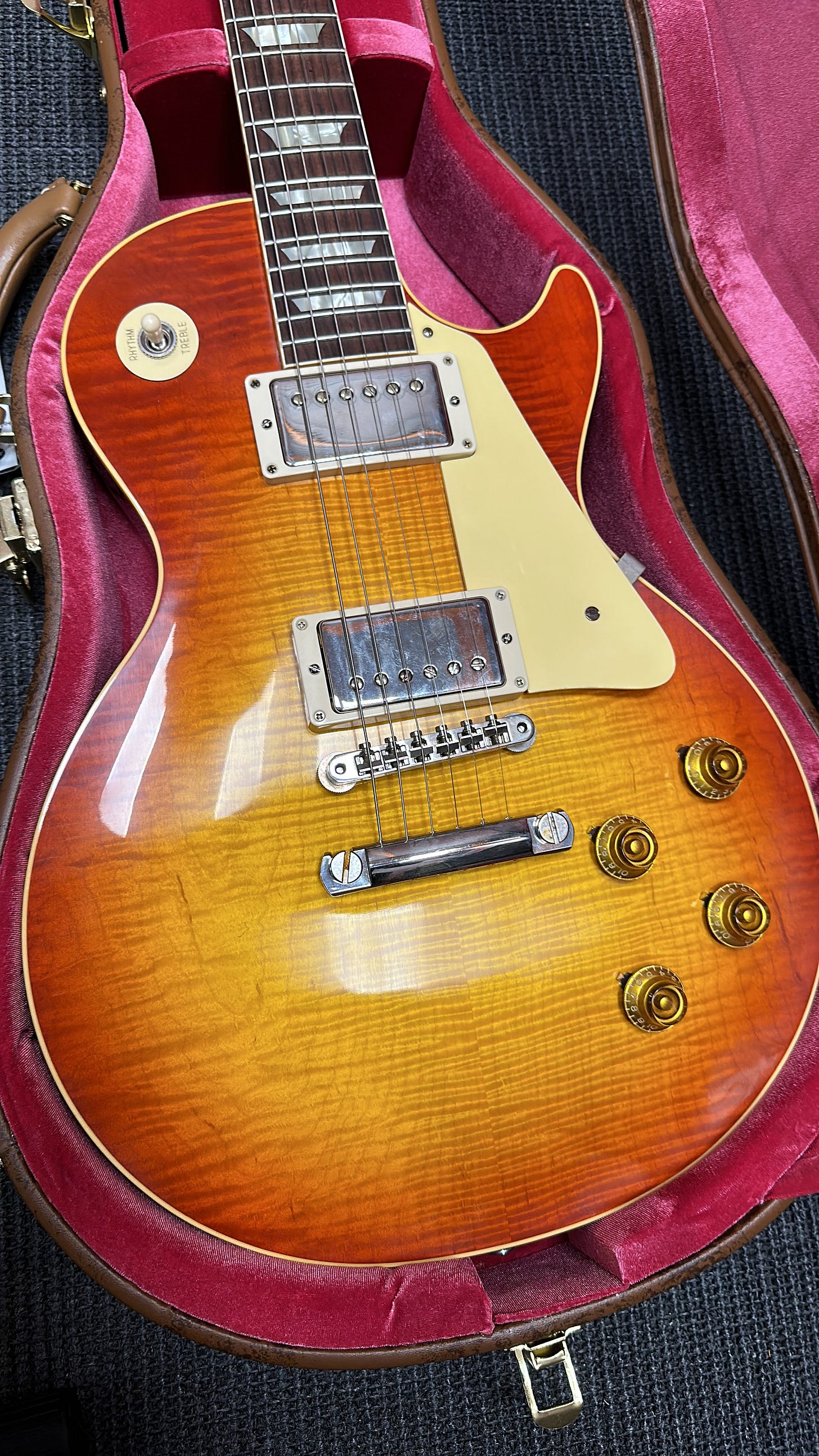My experience of buying a 1959 Les Paul reissue (an "R9")
Why I wanted one, what it does, and how I chose it
The guitar is a deeply personal instrument. We all play for our own reasons, gravitating towards our favourite players and styles.
And over time, we notice our preferred features that lead to our favourite guitars — pickup configuration, weight, shape, how the guitar sits and hangs, wood choice, scale length, fret size, nut width, volume and tone controls, and so on.
Many of us continue to play other guitars though. For me personally, I think it’s important to be able to pick up just about any guitar and be able to play it, instead of needing one specific model or specifications every time.
Over the years, and the pandemic years in particular, I built a modest collection of 14 guitars. Like a lot of people, I enjoy them not only as musical instruments but as pieces of art in their own right. I like walking into a room and seeing them.
Until recently, when I came to the realisation that I was no longer enjoying having so many. Although they’re nice to look at and play, it’s a PITA to maintain over a dozen guitars. It requires time if you do it yourself, or money if you hire a guitar tech.
I also wasn’t playing all of them. Instead, I found myself playing the same few most of the time. They take up a lot of space too, especially the cases.
So I made a decision:
If I can find one guitar that will replace particular ones in my collection, I’ll sell those and buy that one.
The quest had begun.
Choosing which guitars to sell
Last year I bought a PRS Custom 24, one of the Core models. It is by any metric a magnificent guitar:
It’s also incredibly versatile. I won’t do a deep-dive into its specs here but its 5-way pickup selector gives almost every tone you can think of, making this a perfect guitar for anyone who needs to cover a lot of ground in one set.
Over time, though, I came to the conclusion that I didn’t love the neck size. It’s a little thinner than I prefer.
There was also a Gibson Les Paul 1958 reissue, a 2011 model which I purchased in 2020. It’s a ferocious guitar, with a phenomenal tone. The baseball bat neck was more comfortable to me than the PRS, and it’s a joy to play.
Played back-to-back with the PRS though, it became apparent that it lacked the same articulation in single notes. Its strength is in its midrange tones, but it can’t go far beyond that. It’s also slightly heavier than I’d prefer and that fat neck adds some extra difficulty to reach the higher frets.
The third guitar on the chopping block was a Fender MIM Telecaster. Again, a lovely guitar, but one I seldom played.
I mainly played the Tele for its brightness.
So, here was my conundrum: can I find a guitar that will sufficiently cover the Les Paul’s midrange punch, but also be capable of bright tones like the Tele and PRS, with ample clarity in the notes?
To be clear, I wasn’t expecting a guitar to be a direct clone of each of them. What I wanted was something that could get me into the ballpark of each, like this:
Choosing which guitar to buy
What I was looking for was my dream guitar. If I’m selling multiple guitars that I bought intentionally, they would need to be replaced by something amazing.
I already knew that I’m most at home on a Les Paul, partly because of the feel and playability, and partly because of the variety offered by the 4 knobs, as I’ve talked about before.
I also remembered playing a 1959 reissue earlier this year. A private seller had listed one and I took the opportunity to play it. I recalled being amazed at its brightness — it was so much brighter than my ‘58 reissue, with unbelievable note definition.
So off I went to a big guitar shop to see what I could find.
Over the course of 8 hours across 2 weekends, I found it.
My dream guitar.
It’s a new 1959 reissue.
The neck is chunky, but slimmer than my R8.
It’s nice and light (8.4lbs).
Unplugged, it’s loud and resonant.
Plugged in, it covers all the bases I wanted.
Modern Les Pauls have a reputation as sounding fat and sometimes muddy on the neck pickup. Great guitars for big chords and warm leads, but not so good for brighter tones or single note definition.
But if you’ve ever watched videos of the original ‘Bursts, you’ll notice they weren’t always that way. They used to be called “Tele on steroids.” Both pickups were bright and articulate. This video by Emerald City Guitars is a nice demo.
This is where the new Custom Shop reissues really excel, in my opinion. Gibson’s new Custombucker pickups manage to capture that clarity, the brightness, but also still able to dial in the fatter sounds.
So what I have now is a guitar that’s fairly light, very comfortable, effortless to play, and very versatile. Having dedicated volume and tone control for each pickup opens so many tonal options, allowing the guitar to cover the big fat midrange tones yet also get close to the brightness of a Tele.
The middle position of a Les Paul is magic, by the way. You can blend the two pickups with fine measures, and you can spend hours in that position alone.
To give an idea of how bright and clear it is, I recorded an audio clip and sent it to a good friend of mine — a guitar player and audio engineer.
“What guitar do you think this is?” I asked.
His reply: “It sounds like a single coil at times. Is it a Tele?”
That’s the magic of a good Les Paul. I now have a guitar that can do “the Les Paul thing” of fat tones, but rolling a couple of knobs opens up sounds that many people wouldn’t associate with it.
How to choose a guitar in a shop
This is a question a lot of people have when looking for a new guitar: how can they actually choose it?
I’m in the fortunate of having two large guitar stores within an hour of my house, one of them being Anderton’s.
Both of them have a large amount of stock of guitars at every price point, including Custom Shop Gibsons and Fenders. They’re also both relaxed about playing whatever guitars you want and taking as long as you need.
These things aren’t true of every guitar shop, and I’ve been in more than my fair share that treat players with disdain — “you want to play them?” Every person that walks through the door is treated like a thief or someone who’s interrupted their leisure time.
So step one is to try to find a shop that will let you try the guitars (especially if you’re shopping in a premium price bracket).
Then, your goal is to assess the guitar. There are obvious visual inspections, like does it have any problems with the finish or wood, are the frets level, that sort of thing.
Then, how does it feel? Does the neck feel good in your hand? Does it have the upper fret access you need? Is it comfortable on your lap (e.g. I’m not a fan of the Flying V shape because it doesn’t sit in the same way as other shapes)? If you stand up with it, is the weight comfortable?
Plug it in. How does it sound? Bear in mind that you can adjust the pickups in the guitar and change them entirely. If you move the tone and volume knobs, does it have much impact on the sound? Some knobs are very responsive, others not so much. This doesn’t mean it’s a bad guitar, but you might decide to replace the pots at additional expense.
Also try it through a couple of different amps to see how that changes things, as well as how the guitar responds to different settings on the amps.
Basically, you’re trying to familiarise yourself with the guitar.
If you’ve been playing for a while, it’s also beneficial if you have some idea in your head of what you’re looking for. There's no greater feeling than plugging a guitar in and immediately saying “Aha! That’s the tone I want!” If you don’t know what you’re looking for, you’re more likely to love everything you try because almost every guitar has something good about it.
So that’s been my quest. Acquiring one guitar that has allowed me to sell three others, reducing my collection and letting me have a dedicated #1 guitar that I’ll never part with.


